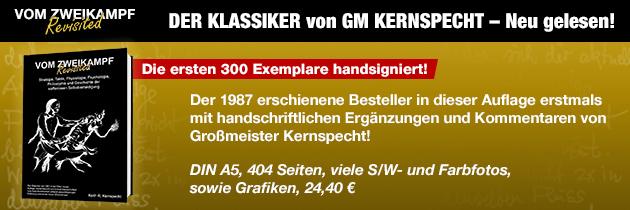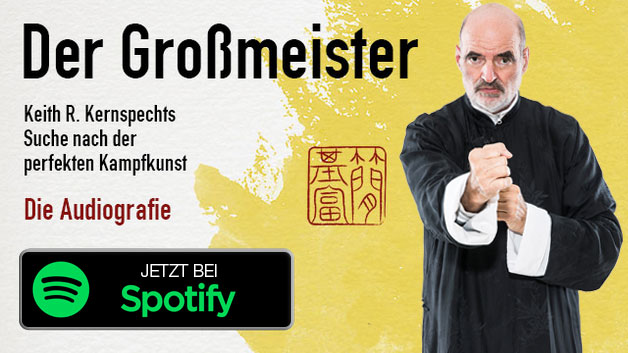Full of skill or stuffed with knowledge? – Christoph Bürk
Impressions after a private lesson with Grandmaster Kernspecht
Dear Si-Fu,
During the course of yesterday’s private lesson with Sifu Xaver Hörmann 5th PG, Sifu Bodo Seibold 4thTG and myself, you explained in detail that refining the four so-called "semi-reflexes" in Leung Ting WingTsun plays a more important role than has generally been thought. If a WT-follower had the capability to execute these four passive movements on a genuinely tactile and reflexive basis, he would certainly be able to remain completely unaffected by the aggressive contact arising from most conventional attacks.
The main point is to remove oneself completely from the force exerted by another person, and lose 100% of this external force. Absorbing the opponent’s force or using it against him is only of secondary or subsequent importance. But how does you gain the ingenious capability to apply precisely these movements (Bong-Sao, Tan-Sao, Jum-Sao, Kao-Sao) at the right point and as "tactile semi-reflexes"? This battle for joint positions, angles, the relative tension of one’s own and the other person’s muscle groups, plus occupying the centreline, immediately reveals one’s own personal limits and confronts the WT-follower with a practically impossible challenge. But clearly this problem also has a solution, for there are people who have this particular skill, who perhaps possess a certain consciousness in every joint and are able at just the right time to adopt exactly the right position, and use precise coordination combined with a lightness of touch to completely absorb the opponent’s force.
In my opinion the curse is always one’s own, personal ego, and also perhaps the WingTsun system itself. Speaking for myself, I repeatedly catch myself being more interested in the "higher" WT programmes and devoting more training to the wooden dummy than concentrating on the core or basis of the system. Clearly enthusiasm and a measure of fanaticism play an important part here, but one should always restrain oneself a little, refrain from running blindly after lifeless techniques and refuse to attach too much importance the "section dance", the "two-man form". In no way do I wish to criticise WT itself, the forms, Chi-Sao or the teaching method, but I have always experienced WingTsun as a principle or means of expression, and not as a collection of lifeless techniques (although I do not claim to do this myself, I am miles away from managing this).
Again and again, black belt and senior Dan grades tell me that they "were unable to apply anything in the street". In my own view the problem lies in the fact that at the beginning of his martial arts career, the student is obliged to start off with "lifeless" techniques. How else is he to learn unfamiliar movement sequences and new coordination patterns, if not by imitating and copying his teacher?
The same happens in WingTsun. The student learns by imitating the basic techniques of his teacher, which are shown to him in classes or he believes he has identified. This method starts in the lower student programmes and continues through the Technician sections, the Biu-Tze and the wooden dummy forms.
During the process the teacher is literally digging his own grave, as somebody who "only" teaches techniques will logically be judged and assessed according to these techniques by his students. I usually hear from students that the best teacher is the one who teaches the most techniques, that the best seminar was the one where they learned the most techniques, or that a class was "fantastic" because they learned and saw a large number of techniques, variations, fancy movements and other "gimmicks". Conversely, the teacher also wants to be a good teacher to his students, therefore he teaches lots of techniques and even more variations to satisfy the students’ hunger for even more techniques, or to flatter his own vanity, or simply to keep his students keen and fill his school. This is the downside of being a WT teacher – when enthusiasm must give way to financial needs.
But what use are the most "fantastic techniques" if I cannot apply them? Personally I find the basis of a martial art (kihon in Japanese), the core of the matter, to be the most important. I hope that at some time in the distant future I might reach the point where I can forget all the "techniques", and only express the "core of the matter". Only then will I know whether the long years of training and study have been worthwhile.
"When you have completed your physical training, turn your gaze inwards and see what damage your mind, soul and heart have sustained!" (Stephen K. Hayes).
I think it is extremely import, and indeed vital in the martial arts, to train for the basics and focus all your concentration on the centre. In my view, and in contrast to the above definition of a "good teacher", the most suitable teacher is one who can embed quality within quantity, which means that the student obtains an insight into the quantity of WingTsun (although whether that is at all possible is a matter for further discussion) and unconsciously practices the core, the quality of the system. This is both unfortunate and very dangerous, however.
Unfortunate because it is an attribute of western society to hunger for sensations and action-packed situations. Most students immediately want to get down to brass tacks, i.e. sparring, applications, combinations, etc.
The danger arises if we place the emphasis on these needs, and only go in search of extraneous technical variations and application tactics. If our students compare their "collected techniques" to establish their pecking order within the group, and judge their teacher by the number of different techniques he has mastered and teaches, then we have reached the pinnacle of quality loss (and things can only go downhill from there).
Practicing the four "core movements in WingTsun" (Bong-Sao, Tan-Sao, Jum-Sao, Kao-Sao) in such a way that they can be created or formed as a reflex-like action is not suitable for somebody who is looking for action-packed acrobatics. The fight for angles and positions, occupying the centreline and the spaces around it, is only possible at very slow speed and with full concentration on coordination and awareness.
As a result this training method is not particularly attractive for the student, as an understanding of the preconditions for a movement only develops after years of training.
Most of the students I know prefer to train Lat-Sao sparring rather than one-armed Chi-Sao (though this depends on the level of motivation by the teacher).
In my view it would also be negligent of us to give students the illusion that they can cope with the typical street thug if we only teach them Chi-Sao. Accordingly it is clear that teaching various techniques also has its justification.
The development of a WingTsun fighter is characterised by different phases: hardness, softness, power, speed, elasticity, stability, sensitivity, tension, etc. Only when all these phases have been trained and experienced can an integrated circuit (or multi-dimensional sphere) be formed. The geometrical characteristic of a sphere already demonstrates that it is possible to reach the core at any time and extremely rapidly. Just as a WT-follower should be able to adapt his four tactile semi-reflexes to the relevant situation at any time and at any point.
Learning WingTsun might be compared to building a palace or a castle. Every technique, every detail of the footwork and every form is a stone, window or tower of our personal WT castle.
But we should be careful not to add too many turrets, windows, bays and projecting structures, while neglecting the foundations. No castle can stand firmly and lastingly on shifting sands. These remarks reflect my own opinions and personal view of various problems and situations. I apologise in advance if anybody should feel I have insulted them or trodden on their toes. I am always willing to enter into a discussion on the points I have raised above.
"True words are not fine – fine words are not true" (Lao-Tze)
Best wishes from an autumnal Allgäu,
Your To-Dai
Christoph Bürk, 3rd TG WT
Contributions:
- Editorial: Full of skill or stuffed with knowledge?
- Full of skill or stuffed with knowledge? – Sifu Bodo Seibold
- Full of skill or stuffed with knowledge? – Markus Senft
- Full of skill or stuffed with knowledge? – Sifu Thorsten de Vries
- Full of skill or stuffed with knowledge? – Sifu Stephan Bollen
- Full of skill or stuffed with knowledge? – Sifu Kasper Lund Nielsen
- Full of skill or stuffed with knowledge? – Sifu Michael König
- Full of skill or stuffed with knowledge? – Sifu Andreas Tomczak
- Full of skill or stuffed with knowledge? – Dai-Sifu Oliver König
- Full of skill or stuffed with knowledge? – Sifu Jörg Kilian
- Full of skill or stuffed with knowledge? – Christoph Brük
- Full of skill or stuffed with knowledge? – Pavan




